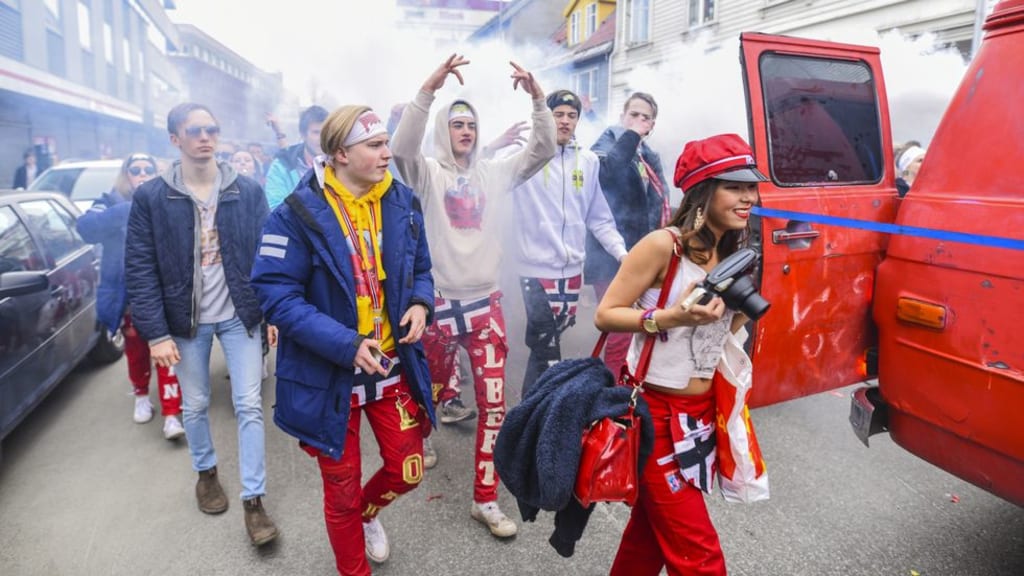Traveling to Norway in May? Make Sure You Check out the Famous Russefeiring
If you are ever visiting Norway in late April or early May, you do not want to miss the russefeiring. Here are seven things you should know about the famous Norwegian graduation party.

Norway, a place of everlasting winters, where polar bears roam the streets, and you can ski to the shops, and everyone you meet is a descendant of the most debaucherous Vikings. While the first three are most definitely false, a foreigner could be forgiven for believing the last one; especially if they arrived in Norway between late April and early May when the famous russefeiring is taking place. Here are seven things you need to know about the russ.
1. It's an old tradition

The origins of the russ can be drawn back to 1905 when the red (russ) caps were used as a symbol of a student completing school and receiving admission to university or college. There were some celebrations and probably some modest parties, but over the years, the russ has transformed into a massive three-week party that involves many elements that have themselves become traditions.
2. There are costumes
Okay, so not exactly costumes. Each student due to graduate is given a set of overalls and a cap that are red, blue, green, or black. The color is based on the subjects that were studied. Those wearing red (or general studies) are the most numerous on the streets of Norway. Many students choose to customize these overalls by adding patches and writing quotes on them. Common things to see are names, the year of graduation, and other things that have meaning to the wearer.
3. It's all about the bling
Just like many graduation parties, there is a fair bit of drinking, a fair bit of partying, and of course, a fair bit of outrageous behavior. Every year there is at least one list of dares that goes about that students are encouraged to complete for nothing more than the fun of it and the knots (Russeknuter). Each of the dares on the list is associated with an item (knot) that is tied to the cap to show how daring someone is.
These dares could be as innocent as going to school 30 minutes early and spending that time in a tree, symbolized by a twig, to more devious activities, like performing a pole dance naked on a streetlight in a public place, symbolized by a light bulb. There is often a prize at the end for the person who collects the most knots. There are some dares that involve acting out in school because these students are still actually attending classes. Most of the dares don't cost very much, but another Russ tradition takes bling to a whole new level...
4. Forget the Venga Bus
A project that starts months before the Russ begins is the "russ bus". A group of students (generally between 15 – 25) will buy a bus and then turn it into a party bus. They usually have some theme, they are often bright colors, and they always have a music system installed that lets you know they are coming well in advance. These buses don't come cheap, with some of these modified vehicles costing up to US$116,000!
5. It's a pre-graduation party
The russ usually starts around the 20th of April and carries on for three weeks until the 17th of May – Norway's national holiday. During this time, the students haven't actually graduated yet, they haven't even taken their final exams.
In recent years, there has been talk of changing the dates or perhaps the exam schedule, but there is always push-back. There are some in the community who feel the partying is getting a little too hard, but there are many others who support this enduring tradition especially since there are ways non-russ get involved.
6. Gotta catch em' all

One of the most adorable russ traditions is young children collecting russ cards - "russekort". Participants of the russefeiring will have made and printed personal cards to hand out over the three weeks. The card contains details like the student's name and school, has a photo, and usually a quote and some social media contact details.
The idea is that the russ can swap them with people they meet so they can keep in touch in the future, but somewhere along the lines, it also became something that young children collected. Every year, in every schoolyard, there are rumors, such as the person who collects the most cards wins an Xbox, these are false. Still, many parents like how it emboldens their children to speak to older students so they can ask for a card.
7. Many russ participate in a fundraising activity called Russedugnad
As you might know, Norway is one of the richest country on earth. However, the teens are usually not able to pay for a bus costing up to US$116,000 with their own money. Therefore, they will often organize a fundraising activity called "Russedugnad" or "Dugnad for russ". Simply explained, the russ sell household products (e.g. toilet paper) with profits to friends, family and neighbors. In recent years, firelighters has reputedly become one of the most popular products to sell on dugnad for russ. With Norway's blistering cold winters, I guess it is not difficult to understand why.
Additional reading
That is the russ in it's most basic form. Lots of additional information can be found on the internet. If you're curious about the shenanigans that the students get up to, you can search for "Norway Russ" on YouTube, but be warned, there is a lot of wild stuff that happens...
About the Creator
Jenny Williams
Hey, I'm Jenny. I blog about culture and lifestyle related topics.






Comments
There are no comments for this story
Be the first to respond and start the conversation.